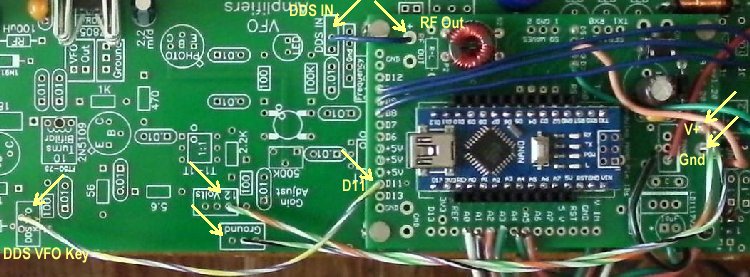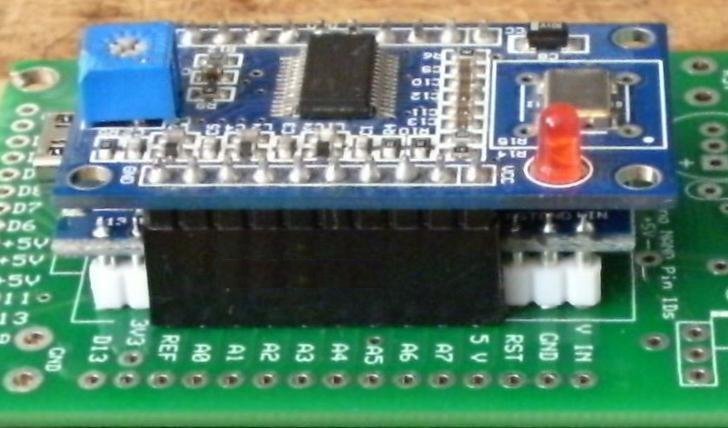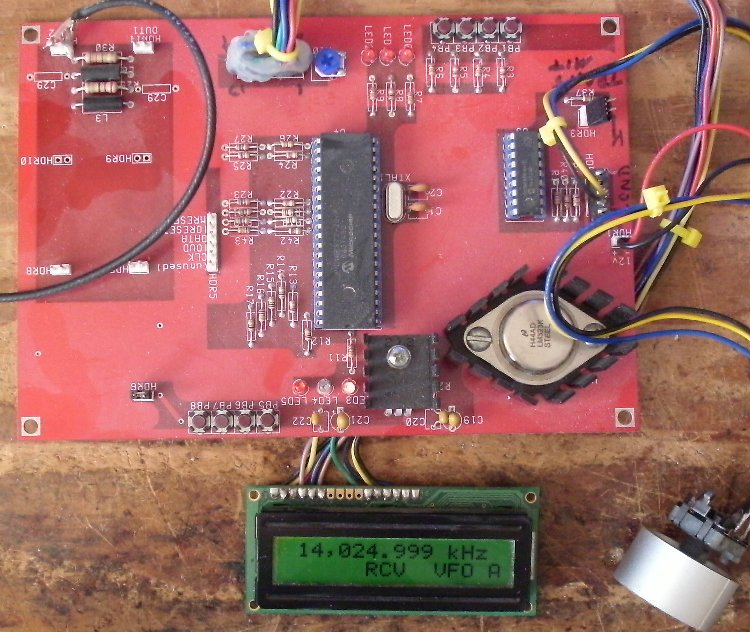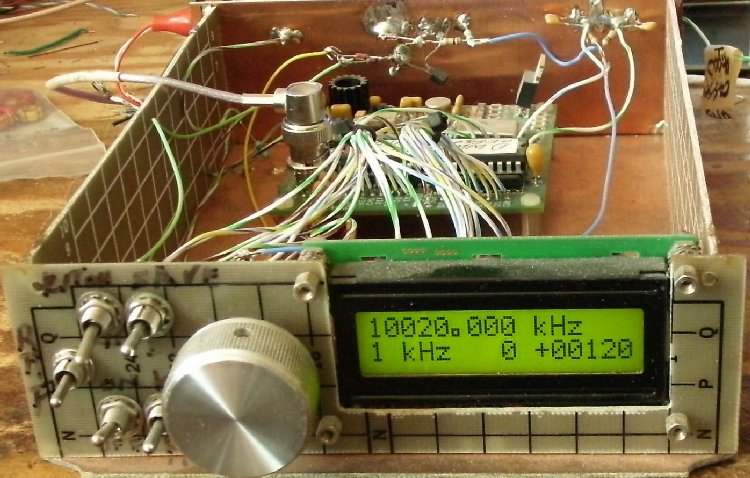


|
You can upgrade the ELR to a DDS VFO with this board as the holes in the corners match holes around the VFO in the Electroluminest Receiver. And it ties into the First Mosfet Amplifier and works very well with plenty of drive for the First Mixer. This DDS VFO is the one that is used on the BLT but is a separate board that can be used with any receiver that can use a DDS VFO and add the transmit function. |

| The board build and its instructions for use can be found at Blue Lightning Transmitter PIC DDS VFO Board |



|
This board is used for those who would rather use Arduino programming to control the DDS rather than the PIC chip programming for the receiver. The PIC DDS VFO is not built on Board 1. The Arduino board is mounted on top of the PIC PCB area and uses all the connections normally used for the PIC. The top picture shows the Arduino DDS VFO mounted on the Experimenter Board for the Arduino NANO and Type-2 DDS made by Jim Giammanco, N51B. It is tied into the BLT DDS VFO for the rotary connections, switches and the LED readout. The bottom picture shows the NANO mounted onto the board. The DDS plugs into the plug in strips above and the NANO plugs in below the DDS for a very compact setup. The project is done with an Arduino Uno and the Experimenter board. Below is the schematic. The link to build this board for mounting onto Board 1 of the BLT: Arduino DDS VFO build for BLT. It shows how to build up the Experimenter's Board and tie it onto the BLT connecting all the switches, the LED and the rotary encoder. |


|
This is an open source AD9850 DDS VFO that can be used with the Blue Lightning Transceiver. Features include 1 Hz to 100 kHz tuning steps, rotary tuned, built in iambic "B" mode keyer with message memories, audio mute, transmitter keying outputs and side tone generation, programmed HF ham band frequencies, BCD band outputs for selecting filters, programmable IF offset, and clock calibration. It is controlled by five switches and a rotary encoder. It has the ability to eliminate the offset frequency for CW output at the receiver's frequency. Below is my crude build using the XMEGA-A3BU Xplained evaluation board. Programming the board is explained by Steven Weber, KD1JV and is easy to do. |

|
The small display is the only downside to the project. A couple of customers have built this project using lens taken from retangular magnifying glasses, found at a Dollar Store or hobby stores and mounted in front of the display. Another building aid to make it look better is that connections come out front with the evaluation board, but can be heated and pushed to the back of the board so the front looks clean. The BCB band outputs for filter selection can be utilized by using an MC14028B. With the external Rx/Tx keying input, your can use your own iambic keyer or straight key. The AD9850 board from China is available for $12 to $15. The XMEGA-A3BU Xplained evaluation board is $35 from either Digikey or Microchip. KD1JV's site information is at XMEGA-A3BU Xplained | AD9850 DDS controller firmware |

|
This kit has a transmit function/switch with key to ground. It is no longer in production, but if you have one it can be used with the BLT directly tied into the DDS VFO In box. Information about the kit can be found at his website www.aa0zz.com It uses an AD9854 DDS chip, lowpass filters, and RF amplifiers on a red-soldermasked PC board. It is a high performance HF VFO for use on the bench as well as tied to the Blue Lightning Transmitter. |

| It is very quiet and a high quality build. The transmit switch is in the upper right hand corner where some lettering has been added to the board. |


|
This is another high quality, quiet, very functional DDS VFO. Transmit keying is available. His home page is Hagerty Radio Company Custom offset frequencies are available so it can be used with the BLT. Made on a 4 layer PCB board as recommended by the Analog Devices for the AS9951, it works very well. The picture above is the one I used with the ELR, but it works well with the BLT also. Ties into the DDS VFO In box. If you already have one and want to use it with the receiver, contact him and he will send you another processor with the offset needed for the BLT. |


|
The software for the receiver will work with the PIC-EL kit 1 and 2. I have not tried it with the PIC-EL 3 but I see no reason why it should not. PB3 on the PIC_EL is the transmit switch. To use the instructions for the BLT kit, PB3 is Button 1, PB2 is Button 2, and PB1 is Button 3. See DDS Instructions for how to use it with the receiver. You have to remove the transistor for the speaker on the PIC-EL 1 and 2, a 2N3904 Labeled Q5, or the resistor labeled R20 right next to the transistor between it and PB3. It is easier to remove the resistor (see yellow arrow). PB3 on the PIC_EL is the "KEY" connection as this will be grounded with a key (iambic or straight) to transmit code. Tie the output of the PIC_EL to the DDS VFO In box on the BLT. You need to have the DDS30 or DDS60 installed on the PIC_El. In the programming for the PIC16F628(A), you will need to have the AD9850 selected for the DDS30 and the AD9851 selected for the DDS60. The oscillator selected for either the PIC16F628 or 628A should be XT_OSC for the PIC_EL. For the DDS30, the crystal used for the AD9850 is 100MHz rather than 125MHz for the China DDS modules. So the code needs to be changed for the Osc Freq of the AD9850 from 125 MHz to 100 MHz:
|

Send E-Mail || Amateur Radio Receivers || Blue Lightning Transceiver

